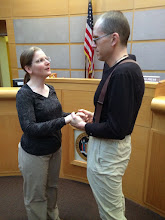
The four-hundred-year-old book behind the exhibit glass didn't engage me right away. I felt a connection only later, after two accidents of timing. Since last night I've tried to figure out how to describe that connection, and I've spent most of that time wishing I could come up with metaphors that don't sound hackneyed. Occasionally my wishes come true. Then there are times like this. That book was like an ancient insect suspended in amber: I was able to connect not only with the tiny artifact, but with the history that flowed around it.
The placard said that the book contained a fold-out image from the Peutinger tablet. "What's that?" I said to myself, and then took out the iPhone I'd bought just days before and Googled it. Between the placard and the internet I learned that the Peutinger tablet is a medieval painted copy on parchment of an ancient pictorial itinerary used by Roman armies and provincial governors. In 1508 the copy made its way into the hands of Konrad Peutinger, an eminent German antiquarian, and was first published in the 1590s.
Less than two days before I read all this, I had been fascinated to learn that Ptolemy's knowledge was unknown in Europe for the thousand years before the Renaissance. Noting that the source for the Peutinger tablet was made near the beginning of that era, I wrote the following in my notes.
!!!Was the Peutinger tablet a transmission vector for Ptolemy??I looked at the book. I looked at the partial image of the Peutinger map on the tiny computer in my hand. The map was clearly schematic: It showed the roads but not the true shape of Italy. I thought of how Ptolemy, who strove to define those true shapes within an objective framework, was all but lost to the West for a millennium, and how the fourth century original of the Peutinger map was made at the dawn of that millennium. When I looked back at the book, I felt like I was touching the flow of history.
No, probably not, because it was from the fourth or early fifth century. By then Ptolemy was unknown [in the West], yeah? And this is a perfect example of what Whitfield was saying: the Peutinger tablet was anti-theoretical! It was for keeping control in the empire, rather than figuring out the outer world within an objective framework!
Yesterday I saw images of the entire tablet online, and that feeling surged back: the book wasn't just a book. It was a window into the era of cartographic divergence that Peter Whitfield described in The Image of the World.
By the first century A.D. Greek-Roman geography formed one intellectual tradition. All the major scientists were Greek, but writing within Roman institutions; owing much to roman civil and military culture, but representing the development of Greek thought over six centuries. The Greek genius was peculiarly analytical and theoretical, and to this tradition the Romans contributed little if anything. The typical Roman scientist-philosopher was Pliny, the hunter-gatherer of flora, fauna, facts, artefacts, lore and legend, but utterly lacking the analytical impulse. The theoretical spirit reached its culmination in the work of Ptolemy of Alexandria (c.A.D.90-168), who consciously summed up the methods and materials of his predecessors. Ptolemy stood at the end of a line of precocious achievement in classical science. The process by which his work fell into neglect had two main aspects. First, the Roman distaste for theoretical geography; second, the radical discontinuity in learning and literature from the fourth century onwards...The Peutinger map, with its focus on roads and the distances along them between cities and towns, was clearly designed to be a highly functional tool, but it's not a map in the strictest sense. It's a schematic. Like a modern subway map, it contorts geographical relationships to array all points of interest within the workspace; geography is subsumed under human utility. This is the antithesis of Ptolemy. In his intellectual landscape the mundane world fits into a framework of graticules that seems almost like a Platonic ideal; here too the earth is subsumed but there's a critical difference: it's subsumed under a concept. The people who had the Peutinger map made had no time for such rarefied ideas: they were busy trying to hold together an empire. Controlling the economic and military forces flowing through that empire was like holding onto a gigantic bloodhound: powerful muscles tensed, bones shifted, skin slid freely and the grip was lost. And all this time, Islamic scholars were looking at Ptolemy's notions and saying to themselves "This is interesting. This is worth copying." While one empire fell, a seed of future empires was wending its way through quills far off in the east. I touched a small piece of the detritus from that sweep of history, and I feel honored. I think this is the way museums are supposed to work. I'm just getting that.

2 comments:
You have presented a Ptolemy World map, which is based on another projection than the one you show. Ptolemy developed three projections, the map seems to be based on one with straight longitudes, not curved.
Thank you thomas! Until you pointed it out, I had no idea how misleading my image was. The projection diagram comes from this page about the Newberry Library's Ptolemy exhibit. I try to cram a lot of concepts into very simple header images, and in this case I was trying to convey how Ptolemy's concepts bypassed the West (hence the arrow going behind the Peutinger tablet) and then came back to inform Renaissance mapmakers. I didn't mean to imply that this particular projection went with that particular map, but now I see how it looks that way. When I find a good image of the proper projection, I'll alter the composite image.
Post a Comment